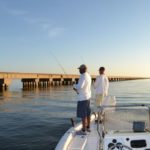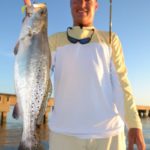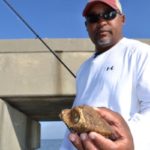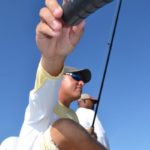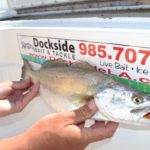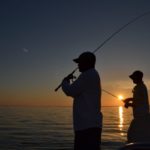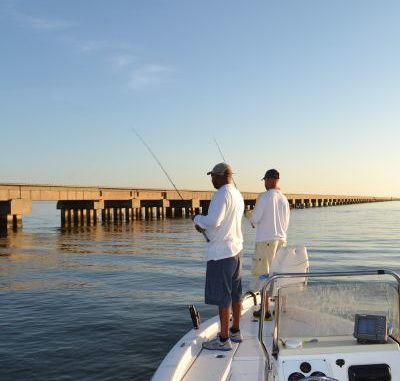
The Lake Pontchartrain Trestle is a challenge to learn to fish, but there’s no better time to try than now, when stout speckled trout are just about jumping in the boat.
Many of the Trestles trout that ended their day in an icy coffin had a bat ray to thank.
Capt. Jonathan Allen, like most of the successful anglers on Lake Pontchartrain’s bridges, is a compulsive hook-setter. If so much as a single blade of hydrilla brushes the tail of his bait, Allen sets the hook.
As a result, he catches a ton of fish that other anglers would miss, but he also snags the bottom more than a jetty anchor.
Allen thought the latter was the case when he yanked his rod heavenward, and the jighead didn’t move 1 square inch.
But then, almost like a delayed reaction, his line started drifting and his rod tip bucked two or three times.
“This definitely isn’t a trout,” he said. “Either a big drum or a bat ray.”
Bat rays are massive stingray-resembling fish that move through the Trestles in large schools. They’re kinda cool looking, but are the bane of speckled trout fishermen.
Allen would grow to have a particularly sharp, venomous hatred for this one.
It took the fish a full minute to even realize it was hooked, but once it did, it headed with defiant certitude away from the Trestles and in the direction of the Highway 11 bridge.
But Allen wasn’t going to surrender his 3/8-ounce jighead and Matrix Shad soft-plastic to the flapping fish. He had a boatload of replacements, but it was more the point of the matter.
He thumbed his drag, trusting his PowerPro to hold true, and finally turned the fish. He deftly worked it to the side of the boat, where the fish made repeated lunges in futile attempts to free itself from the strange force that kept pulling it to the surface.
After several minutes of intense battle, Allen finally had the exhausted fish boatside. The guide could see his unharmed jig lodged in one of his foe’s massive wings. He placed his rod next to him on the boat’s floor, and grabbed the monofilament leader to begin to extricate the lure.
The fish, however, objected. It found strength it didn’t know it had, and surged to the bottom like a bluefin tuna still green after a short battle.
The line sizzled through Allen’s hand, and instinctively, he let go. Within about .000052 seconds, the rod and reel followed, destined to be towed around the lake, at least for a little while, by an oversized bat ray.
Allen couldn’t decide who he was madder at — himself or the bat ray.
“That’s a $300 mistake right there,” he said.
He was, understandably, fuming, and that was bad news for the speckled trout population. Allen dug another rod out of his rod holder — one he didn’t like nearly as much as his now submerged Shimano Crucial — and resumed fishing the train bridge.
He became like a man possessed, and the trout didn’t stand a chance.
Allen worked the bridge stanchions with a fresh intensity. He cast in front of, behind and beside them, and pulled trout after gill-rattling trout into his 24-foot Skeeter bay boat.
He had lost his heavy cannon — his 5-foot, 9-inch fast-tipped Crucial — but he wasn’t about to lose the war. The trout brought in reinforcements — looking fabulous in their spotted, iridescent camouflage — and Allen kept picking them off one by one.
This was the rare battle when reinforcements by the other side is a good thing. Fortunately for Allen and others who fish the Trestles this time of year —like Allen’s good buddy, Capt. Kris Robert — the lake sends waves of reinforcements to the Trestles throughout the month of April.
Catching them isn’t always easy. In fact, the lake has chewed up and swallowed more anglers than an Australian crocodile next to an Aboriginal commune with a strict piscatorial diet.
Anglers throughout South Louisiana hear about all the fish coming from the bridges, they see the action on TV, they hear the thud of the full boxes at the marinas and then they go out themselves to try to duplicate the success, only to return home swearing that the whole thing is a conspiracy. They know they must be the butt of some cruel joke.
But these newcomers to the lake all make one consistently crucial mistake, according to Robert.
“Every time I go on a charter, the first thing I tell my clients before we even leave the dock is that the most important thing is to get that lure to the bottom,” he said. “A lot of people will make that cast and as soon as that lure hits the water, they start reeling.
“You want to count it down a few seconds, and wait until that bow comes into the line. Once you see that bow come into the line, you know it’s on the bottom. At that point, all you need to do is barely jig it.
“You’ll see somebody come in with 30 fish; somebody else will come in with two. The difference might have been that the person who caught those 30 fish, they got the lure to the bottom.”
As a general rule, the two anglers cast past the stanchions, let their lures fall, and then hop them back to the boat. Every hop is actually a series of two or three hops followed by a lull in which the lure is allowed to fall back to the bottom. Most of the strikes come on the initial fall or after one of the series of hops.
“Whenever the tide’s running hard — like it’s ripping right now — they’ll hold right up close to the pilings,” Allen said. “A lot of times on that initial fall, they’re going to hit it, so you’ve got to watch your line real close.”
It’s rare for a Trestles fish to rip the rod out of your hands. Usually the angler will detect nothing more than a subtle tick on the line. Other times, the angler will feel nothing at all, but will see his line move in a direction it shouldn’t.
That’s why Allen and Robert set the hook more than Bill Dance fishing a stocked farm pond.
“Anything your lure does that you didn’t make it do, set the hook,” Robert advised. “It’s better to be safe than sorry.”
Most of the hooksets are swings and misses, but other times, they set the hook when something just doesn’t look or feel right, and are rewarded with furious fish.
And these aren’t your grandpa’s school trout.
“The fish have all been nice — averaging about 2 pounds,” Allen said. “They’re anywhere from 14 to 20 inches, and you’ll have a couple of 3’s and 4’s mixed in.”
The hottest spot on the Trestles every year is the southeast corner. It gets loaded with trout, and as a result, it also gets loaded with boats. There’s an inverse relationship between the two.
“If you get two or three days of bad weather where people can’t get over there to fish the corner, what you’ll find is on that third or fourth day, after the weather is over, the fish will bite real, real good,” Robert said. “And then when all the pressure gets on them — all the trollers and everybody else running their motors over them and beating them up — they shut down.
“But when they shut down, if you give them two or three more days, they’ll pick back up again.”
The fish — particularly the bigger fish — are very pressure-sensitive, and Robert uses that to his advantage.
“You see a lot of boats in a certain area, and everybody tends to gravitate to that area because they think that’s where the fish are going to be,” he said. “What you want to do is find a stretch of bridge where there’s not as many boats; therefore, it’s not a lot of pressure on those fish.”
The strong spring action at the Trestles is as certain this month as April showers. Even in years with Bonnet Carre Spillway openings, big, line-stripping specks crowd the legs of the bridge. The strong run lasts at least a couple of months.
“It’ll hold out until the end of May,” Allen said, “but the plastic bite will only hold out until (the middle of May).
“You’ll be able to catch them on the Trestles with live shrimp all the way until the end of May, half of June, and then they’ll start moving out toward the Rigolets.”
At that point, Allen and Robert move with them, targeting big fish at the L&N bridge in the Rigolets, as well as the rigs in Lake Borgne.
The two guides will resort to live shrimp, but until then it’s nothing but 3/8-ounce jigheads and Matrix Shads.
Allen and Robert helped design the soft-plastic baits that have wide tail wiggles and remarkably good action in the water. Their favorite colors for the Trestles vary according to the clarity of the water, but they’ll always have lemon head, shrimp creole, avocado and champagne close by.
They change frequently to see what the hot bait of the day is.
It was unclear at press time exactly which color the bat rays are preferring this year, but if you catch one attached to a Shimano Crucial, call Allen. It’s his.
For more information, contact Jonathan Allen at 985-285-4946 or Kris Robert at 228-284-9502.
